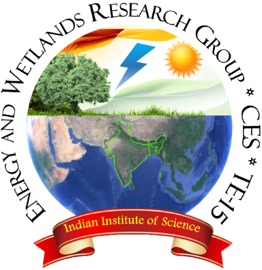 |
Assessment of Physico-chemical Integrity of Lotic Ecosystems in Central Western Ghats through Multivariate Techniques
|
 |
|
Materials and Method
Aghanashini is a west flowing river with catchment area of 1450.9 sq.km (Fig. 1), spread across the districts of Uttara Kannada (Ankola, Kumta, Sirsi, Honavar, Siddapur) and portions of Shimoga (Sorab). The Aghanashini river originates in Sirsi taluk, Uttara Kannada district. The river has two sources – Bakurholé tributary (at Manjguni) and Donihalla (near Sirsi) which meets at Mutthalli (Balachandran et al. 2012; Ramachandra et al. 2015). Aghanashini river estuary has dense and diverse mangrove forests along the coast. Rainfall across the basins varies from as low as 3000 mm at the plains of Sirsi and to as high as over 5000 mm at the Ghats. Temperature in the basins varies from as low as 15.3℃ in January to as high as 35.4℃ in April. Elevation in the catchment varies between less than 0 meters to 786 m of Mean sea level (Ramachandra et al. 2016b). In the current study, Chandikahole’s sub catchments were considered for assessment of flow. Chandikaholé originated at Yaana and joins Aghanashini at Uppinapattana. About 8 macro and micro watersheds were considered taking into account i) similar climatic conditions (about 3500 mm rainfall), ii) all the micro watersheds connect to a macro watershed, iii) variability in landscape, etc.
Yaana, Nanalli, Beilangi, Mastihalla, Harita are the micro watersheds connecting Aanegundi (AGT1), whereas Aanegundi (AGT1 and AGT2), and Bialgadde (BGT) are the macro watersheds. Aanegundi AGT1 and AGT2 join near Yaana cross along the Sirsi-Kumta Road. The descriptions of various micro/macro watersheds sampled are given in Table 1. Yaana and Nanalli catchments are dominated by evergreen forests, followed by Beilangi which consists of moist deciduous forests and evergreen forests whereas, rest of the catchment areas have mixed land use dominated by horticulture and agriculture activities.

 Water Sample Collection
Water Sample Collection
Water samples were collected covering all seasons for a period of two years during April, 2014 to March, 2016 from nine different sites namely Yaana (YK), Nanalli (YNK), Beilangi (BE), Harita (HA), Mastihalla (MH), Aanegundi (AG), Aanegundi tributary 1 (AGT1), Aanegundi tributary 2 (AGT2) and Bialgadde (BGT) and analysed physico-chemical parameters. Water temperature, discharge, EC, TDS, pH, and DO were measured at the collection site and samples were brought to the laboratory for further analysis.
The analysis of physico-chemical parameters like water temperature (laboratory thermometer); discharge (current meter), pH (Eutech: PCSTestr 35); total dissolved solids (Eutech: PCSTestr 35); electrical conductivity (Eutech: PCSTestr 35); turbidity (Hach Turbidimeter); dissolved oxygen (Winkler’s Method); chemical oxygen demand (Closed reflux, titrimetric method); total alkalinity (Titrimetric method); biochemical oxygen demand (5 day BOD test); chloride (Argentometric method); total hardness and calcium (EDTA Titrimetric method); magnesium; nitrate (Phenol disulphonic acid method); orthophosphate (Stannous chloride method); sodium and potassium (Flame emission photometric method) of water samples collected from select streams were done according to the standard protocol of APHA AWWA WEF (2005).
Statistical Analysis
Multivariate techniques, Cluster Analysis (CA) and Principal Component Analysis (PCA) were computed using PAST software considering the water quality data. These techniques like principal component analysis (PCA) and cluster analysis (CA) helps in the data dimensionality reduction while prioritizing the factors responsible for variations in water quality parameters, thus helping in better interpretation of water quality data (Arslan 2009; Zarei and Bilondi 2013; Gebreyohannes et al. 2015; Ramirez et al. 2014). The assemblage of sampling locations based on their similarity were done through the cluster analysis (Bhat et al. 2014; Han et al. 2012; Mushatq et al. 2013).


|
|
Citation : Ramachandra T. V., Sincy V., Asulabha K. S., and S. Vinay, 2018. Assessment of Physico-chemical Integrity of Lotic Ecosystems in Central Western Ghats through Multivariate Techniques, J Biodiversity, 9(1-2): 69-80 (2018), DOI: 11.258359/KRE-179
| * Corresponding Author : |
|
Dr. T.V. Ramachandra
Energy & Wetlands Research Group, Centre for Ecological Sciences, Indian Institute of Science, Bangalore – 560 012, India.
Tel : +91-80-2293 3099/2293 3503 [extn - 107],
Fax : 91-80-23601428 / 23600085 / 23600683 [CES-TVR]
E-mail : tvr@iisc.ac.in, energy@ces.iisc.ac.in,
Web : http://wgbis.ces.iisc.ac.in/energy/
|
|





